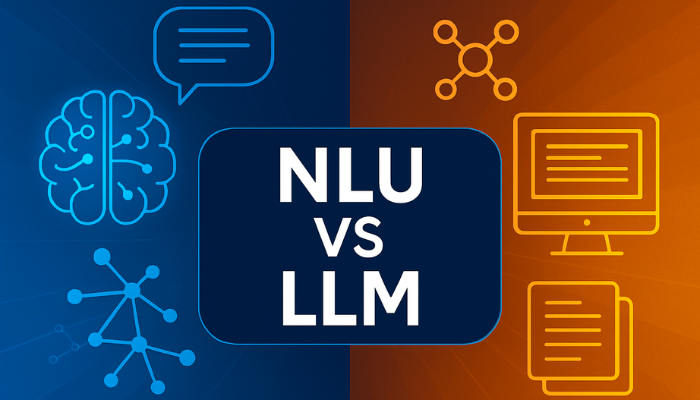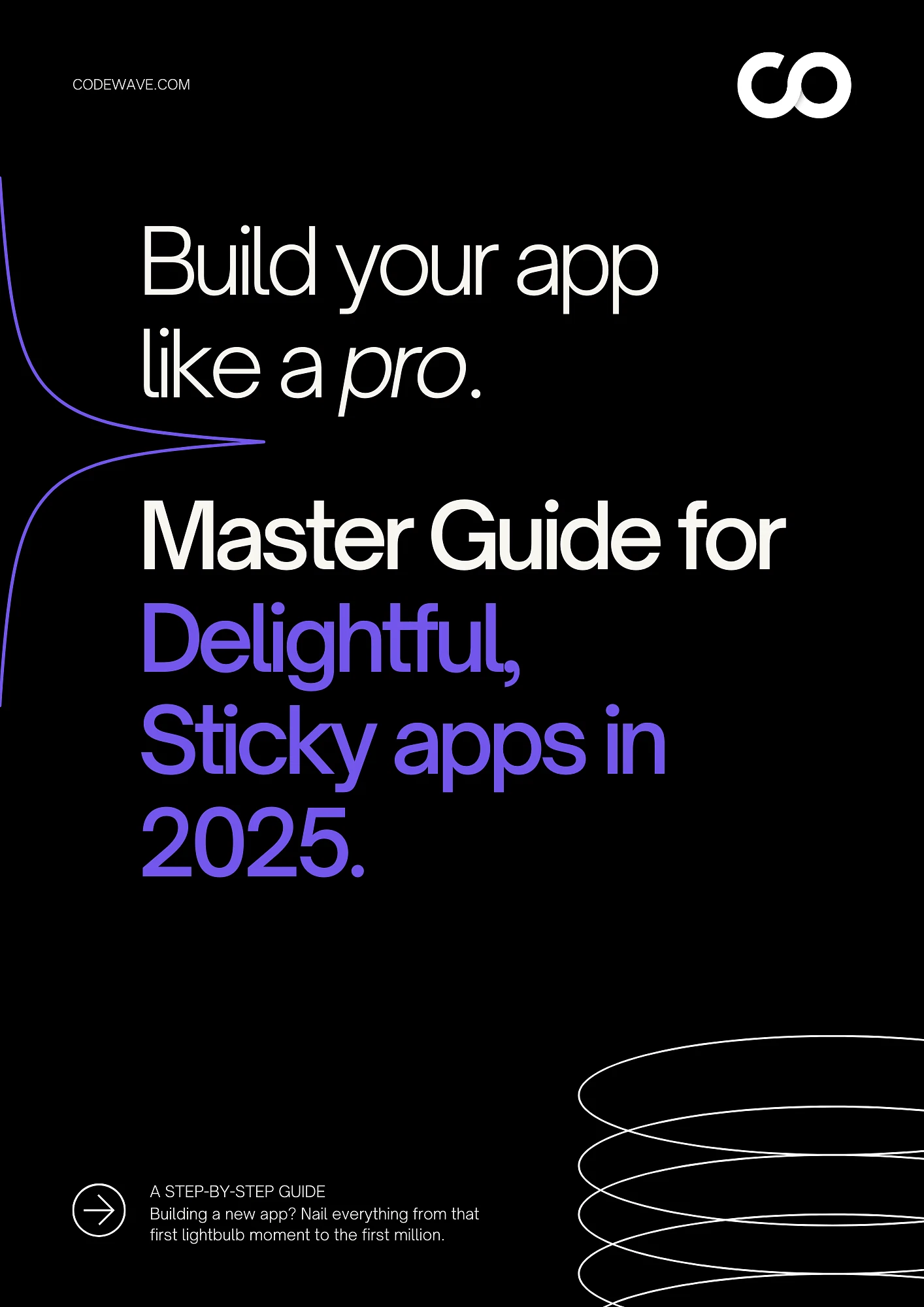“Understanding language is the key to understanding intelligence.”
Geoffrey Hinton
That couldn’t be more true. Today’s AI systems are judged by how well they understand human language. If you’re leading technology, operations, or strategy, you’ve likely heard terms like Natural Language Understanding (NLU) and Large Language Models (LLMs). But what do they actually mean for your business?
NLU helps machines understand what users really mean; making it useful for chatbots, support systems, and internal tools. On the other hand, LLMs focus on generating text; writing emails, summarizing documents, or assisting your teams in daily communication.
Understanding this difference matters. If you apply the wrong tech to the wrong use case, it could lead to higher costs, poor results, or slow adoption.
Here’s what this blog will help you do:
- Understand the core difference between NLU and LLM.
- See how each one impacts business operations.
- Choose the right model for your specific needs.
Let’s get reading!
What Are NLU and LLM?
Both NLU and LLMs deal with human language. But they do entirely different things, and serve different business goals.
What Is a Large Language Model (LLM)?
An LLM is trained on massive amounts of text data to predict and generate human-like text by recognizing patterns. It does not truly understand meaning but creates responses based on statistical likelihood.
In practice: LLMs are used to automate writing tasks, such as drafting emails, generating reports, or answering FAQs, allowing businesses to scale content creation efficiently without human intervention.
The global LLM market was valued at approximately $5.6 billion in 2024 and is expected to grow rapidly, with a CAGR of nearly 36.9% through 2030. This signals strong adoption across industries seeking faster, AI-driven text generation.
For more: Machine Learning Pattern Recognition: A Beginner’s Guide
What Is Natural Language Understanding (NLU)?
NLU focuses on interpreting human language by extracting meaning, user intent, and context. It doesn’t generate text but analyzes input to inform accurate responses and actions.
In practice, NLU powers systems that must understand and respond correctly, such as voice assistants, chatbots, or automated customer service. It helps route queries, identify sentiment, and trigger relevant workflows.
The NLU market is projected to surpass $99.8 billion by 2032, underscoring demand for AI that truly understands language to improve decision-making and customer interactions.
Differences Between LLM and NLU
Let’s go over the key differences that define how LLMs and NLU serve distinct roles in business technology stacks.
1. Core Functionality
LLMs are generative. They’re trained to produce coherent, human-like text based on probability. Their strength lies in generating long-form content, mimicking tone, and adapting style. They don’t understand context but predict what “sounds right.”
NLU, on the other hand, is analytical. It decodes language to identify intent, extract entities, and infer context. Its goal isn’t to “sound human,” but to understand humans, what they’re asking, what they need, and how to respond programmatically.
2. Role in Business Applications
LLMs are used where content generation or language fluency matters; drafting emails, generating reports, summarizing data, or assisting marketing teams with copy. They’re productivity multipliers for content-heavy tasks.
NLU is deployed in decision-critical environments; routing customer queries, automating service workflows, voice assistant accuracy, and internal process automation. It’s foundational in making systems context-aware and responsive.
3. Response Accuracy vs. Fluency
LLMs excel at fluency but can fabricate details (hallucinations), especially when facts aren’t explicitly present in the prompt. They prioritize linguistic coherence over factual accuracy.
NLU systems prioritize correctness, a chatbot misinterpreting “cancel my subscription” as a positive sentiment isn’t just bad UX; it’s a business risk. NLU is engineered for clarity and correctness, not flair.
4. Customization Needs
LLMs often function well out-of-the-box, with broad general knowledge baked in. Businesses might only need prompt engineering or API fine-tuning.
NLU usually requires training on domain-specific data to perform reliably, especially for complex customer queries, multilingual input, or industry-specific jargon. It demands a feedback loop and continuous learning cycle to stay relevant.
5. Interaction Depth
LLMs perform well in single-turn tasks, generate this, summarize that. They struggle with multi-turn coherence in a conversation without explicit memory or prompt engineering.
NLU, however, is built for layered interactions, where the system needs to track user intent across a session, resolve ambiguity, and drive actions like ticket generation or escalation.
6. Deployment Objective
LLMs are typically embedded in tools to enhance human capability, aiding content teams, developers, or analysts by accelerating content tasks. They’re assistants.
NLU sits at the heart of automation engines, enabling bots to take action, CRMs to classify inputs, or contact centers to scale without human agents. They’re decision enablers, not just assistants.
Here is a summarized table that shows clear differences between LLM and NLU:
| Feature | LLM (Large Language Model) | NLU (Natural Language Understanding) |
| Function | Predictive text generation | Language interpretation and context extraction |
| Goal | Automate content creation | Automate understanding and decision routing |
| Output Focus | Fluent and coherent text | Accurate classification and intent recognition |
| Suitability | One-shot tasks, content-heavy workflows | Real-time decisions, conversation-driven automation |
| Customization Needs | Minimal; works broadly with prompt tuning | High; requires domain-specific training |
| Deployment Role | Productivity assistant | Automation and CX backbone |
Aligning your AI strategy with the right technology is essential. Misalignment risks cost overruns, lower accuracy, and slower adoption. As Benedict Evans aptly notes, “While LLMs talk, NLU listens—and understands.” This distinction is key to maximizing ROI and scaling AI initiatives effectively.
Strengths of LLMs vs NLU
Each technology shines in its own way. Let’s uncover how LLMs create and generate language effortlessly, while NLU digs deeper to understand meaning and intent clearly.
LLM Strengths – Language Generation at Scale
Let’s break down what makes LLMs uniquely positioned for handling high-volume language tasks in business and automation contexts.
- Generate reports, emails, and articles automatically
Instead of your team spending hours on sales emails or weekly status reports, LLMs generate 80% of the draft instantly, saving time and reducing copy churn. Your teams just review and tweak.
- Translate or summarize documents
Got a 20-page client proposal in French? LLMs summarize the key points in English in seconds. This becomes especially useful when dealing with multi-region stakeholders or last-minute review cycles.
- Draft code and assist in software development
Developers can describe what they need in plain English, and LLMs generate boilerplate code or even suggest test cases. Think of it as pairing every engineer with a silent, superfast junior dev.
- Power chatbots and virtual assistants
LLMs enable your support bots to respond like humans; context-aware, polite, and accurate. For example, a customer asking for “cancel my trial” will get the exact cancellation steps, not a generic reply.
Worth reading: Integrating LLMs in AI Chatbots: A Complete Guide
- Extract patterns from unstructured text
Say you’re collecting user feedback from 5,000 open-form responses. An LLM can pull recurring complaints or feature requests, giving your product teams clear next steps in one dashboard.
- Support multilingual communication in global teams
An HR team in India can respond to an employee in Brazil in Portuguese, without needing a translator. LLMs ensure tone, meaning, and intent stay intact across languages.
NLU Strengths – Language Interpretation with Precision
Now that we’ve touched on generation, it’s time to focus on how systems decode and act on language input with intent-driven precision.
- Understand context, sentiment, and user intent
NLU distinguishes between frustration and satisfaction in similar phrases. For example, “I’m done with this” could signal churn risk or task completion. This enables proactive interventions before issues escalate.
- Route support tickets and emails accurately
When a customer says, “My card isn’t working,” NLU doesn’t just parse the words; it understands this as a billing issue. This enables accurate routing to finance instead of technical support, reducing resolution time and ticket bounce.
- Enable smart voice assistants and IVRs
In IVRs and smart assistants, NLU eliminates menu trees. A user saying, “I forgot my password” triggers the exact reset flow, cutting friction and boosting call deflection rates.
- Analyze customer feedback at scale
When thousands of app reviews roll in, NLU can surface recurring complaints like “slow loading” tied to negative sentiment. This isn’t just analytics, it informs roadmap priorities grounded in user voice.
- Automate tagging/classification in enterprise tools
Instead of manually labeling Slack messages or support tickets, NLU auto-classifies them by topic or urgency. This saves teams hours and keeps workflows structured and searchable.
- Power personalized user experiences with real understanding
If a user frequently searches “budget team tools,” NLU reads the intent and serves cost-efficient options automatically. This translates directly to better conversions and more relevant UX.
Want to embed real language intelligence into your systems?
Start with GenAI Consulting to design NLU-powered experiences tailored to your users, workflows, and growth goals.
Now, let’s explore how LLMs and NLU tackle real challenges across various industries effectively.
Real-World Industry Challenges Solved by NLU and LLM
NLU and LLM are now part of daily business workflows; powering decisions, automating tasks, and enhancing experiences. Let’s go over key industries.
1. Financial Services
Daily Challenge: Financial institutions face slow, error-prone client onboarding due to manual KYC (Know Your Customer) checks and fragmented portfolio reporting. This delays customer acquisition and strains compliance teams.
How NLU Helps: NLU automates KYC by accurately extracting and verifying client information from documents and conversations, cutting onboarding times and reducing compliance risks. For example, NLU-powered systems can identify and flag missing or inconsistent data instantly.
How LLM Helps: LLMs generate clear, concise portfolio summaries and financial reports by synthesizing large datasets. This supports advisors in delivering timely insights, enabling faster investment decisions and improved client satisfaction.
2. Healthcare
Daily Challenge: Clinicians spend excessive time on paperwork, limiting direct patient care and slowing diagnosis. Unstructured symptom data complicates accurate treatment recommendations.
How NLU Helps: NLU interprets patient symptoms from clinical notes or voice inputs, supporting early detection of conditions and alerting clinicians to critical cases. For instance, NLU can classify symptom severity for prioritizing care.
How LLM Helps: LLMs assist in generating medical documentation, reducing administrative workload while maintaining accuracy and compliance. This frees doctors to focus on patient interaction and strategic care decisions.
3. Retail and E-commerce
Daily Challenge: Managing diverse customer queries and complaints across channels leads to delayed responses and lost sales opportunities. Product descriptions often lack personalization, limiting engagement.
How NLU Helps: NLU identifies customer intent in real-time, routing issues to the appropriate teams quickly. For example, it can differentiate between a return request and a product inquiry, enabling faster resolutions.
How LLM Helps: LLMs create personalized, engaging product descriptions at scale, improving SEO and conversion rates by matching customer preferences and trends.
Also an interesting read: AI Agents Transforming Retail and E-Commerce
4. Education Technology (EdTech)
Daily Challenge: Handling a high volume of student questions and grading assignments manually slows down the learning process and burdens educators.
How NLU Helps: NLU routes student queries to relevant subject experts or resources automatically, reducing wait times and improving learner satisfaction.
How LLM Helps: LLMs automate grading for essays and assignments by evaluating content quality and coherence, allowing educators to allocate time to curriculum development and one-on-one student support.
5. Legal Services
Daily Challenge: Reviewing lengthy contracts for risks and obligations consumes significant time and increases exposure to human error.
How NLU Helps: NLU extracts key clauses, flags potential risks, and classifies contract types to streamline legal review workflows. For example, it can highlight non-compliance with regulatory requirements quickly.
How LLM Helps: LLMs draft contract summaries and generate standard legal documents, accelerating negotiations and reducing dependency on scarce legal expertise.
6. Human Resources
Daily Challenge: Screening resumes and managing employee queries manually leads to slow hiring and poor employee experience.
How NLU Helps: NLU parses resumes to identify relevant skills and match candidates to roles efficiently. It also interprets employee queries for automated, personalized HR support.
How LLM Helps: LLMs generate clear job descriptions and onboarding materials tailored to roles, ensuring consistency and accelerating the hiring process.
7. Customer Support
Daily Challenge: Providing 24/7 support across multiple languages and channels is resource-intensive and prone to inconsistency.
How NLU Helps: NLU detects customer intent and sentiment, routing issues to the right teams or triggering automated responses with high accuracy.
How LLM Helps: LLM-powered chatbots handle complex queries conversationally, providing natural, human-like responses that enhance customer satisfaction and reduce workload on support agents.
After seeing industry challenges solved by NLU and LLM, let’s address the hurdles they face and the solutions.
Challenges of LLMs and NLU – And How to Tackle Them
Before you invest in LLMs or NLU, it’s critical to understand the roadblocks, technical, operational, and ethical. Each challenge comes with real business risk. The good news? Every one of them can be managed with the right strategy in place.
LLM Challenges
Even with their impressive capabilities, LLMs aren’t flawless. Before implementation, it’s critical to understand the key limitations that could impact reliability and control.
1. High Cost to Operate
Running LLMs needs a lot of computing power, which makes it expensive. As your usage grows, so do your cloud and infrastructure bills. If you’re building your own model or fine-tuning one, the costs add up fast, especially with added security and storage needs.
How to Tackle It: Use smaller, task-specific models where possible. Don’t build from scratch, go for API-based services or cloud-hosted models that charge based on usage. This keeps costs under control while still delivering results.
2. Inaccurate or Unreliable Responses
LLMs can sound smart but still give wrong or misleading answers. This is risky in areas like finance, legal, or customer service, where mistakes can cause confusion, complaints, or even legal trouble.
How to Tackle It: Add a review step before sharing outputs publicly, either through automation or human checks. Connect the model to your company’s own data to improve accuracy and reduce mistakes.
3. Security & Compliance Exposure
Using LLMs in business settings brings up major concerns about data safety and legal rules. These models need access to large amounts of data, and if that data includes private or sensitive information, it can lead to leaks or compliance issues, especially in industries like healthcare, banking, or law.
How to Tackle It: Use private instances of LLMs or deploy them in secure, on-premise or VPC environments. Collaborate only with vendors that meet strict compliance certifications and audit their data handling practices thoroughly.
4. Risk of Bias or Reputational Harm
LLMs learn from internet-scale data, which is often riddled with societal, cultural, and linguistic biases. This can result in offensive, unfair, or inappropriate outputs, posing reputational risks, especially in customer-facing contexts. A misstep here could trigger user backlash, compliance scrutiny, or media blowback.
How to Tackle It: Train models on curated, domain-specific datasets aligned to your brand tone and values. Establish human-in-the-loop reviews for critical content and include DEI (Diversity, Equity, Inclusion) checkpoints in model evaluation cycles.
5. Difficult to Integrate into Existing Systems
Plugging LLMs into real-time operational workflows; like CRMs, ticketing platforms, or ERP systems, isn’t straightforward. These models often require new APIs, infrastructure changes, or custom connectors, which slows adoption and strains internal engineering teams.
How to Tackle It: Start with low-risk, standalone use cases (e.g., FAQ bots, internal documentation support). Use low-code/no-code platforms or partner with solution experts who offer ready-made connectors and enterprise-grade LLM wrappers to reduce integration overhead.
NLU Challenges
While NLU adds intelligence to systems by interpreting human language, it comes with its own set of challenges, ranging from handling ambiguous input to maintaining accuracy across diverse user contexts.
1. Weak Multilingual Capabilities
Most NLU systems are trained primarily in English. When users speak or type in regional languages or use mixed-language inputs, the system often fails to understand them correctly. This becomes a big blocker for companies serving global or diverse markets.
How to Tackle It: Choose platforms that support multiple languages natively or allow you to train models in specific languages your users speak.
2. Misunderstands Complex Queries
When users ask long or confusing questions, NLU systems may miss the real intent or extract the wrong meaning. For example, “I can’t access my invoice and also need help updating my email” could confuse a basic model.
How to Tackle It: Build workflows that break down queries or ask follow-up questions. If the system isn’t confident, it should hand the task off to a human agent.
3. Doesn’t Fit Your Industry Out of the Box
Off-the-shelf NLU tools usually don’t understand the specific terms or context of industries like healthcare, finance, or legal. This leads to inaccurate responses or poor automation.
How to Tackle It: Use models that are trained on your industry’s language. You can also improve accuracy by training the system on your actual customer conversations.
4. Can’t Handle Sudden Scale
When many users access the system at the same time, NLU performance can slow down or fail. This creates bottlenecks, especially during peak hours, affecting customer satisfaction and business operations.
How to Tackle It: Select platforms that offer scalable infrastructure with load balancing. Test how the system performs during high traffic periods before launching to ensure smooth operation.
5. Needs Ongoing Maintenance
Language and user behavior constantly change, so NLU systems must be updated regularly. Without ongoing maintenance, the system’s accuracy drops over time, leading to poor user experiences.
How to Tackle It: Implement a regular review and update process, using real user feedback to improve the system continually and keep it aligned with current language use.
Let’s see how LLMs and NLU combine forces to deliver smarter, more effective solutions.
How LLM and NLU Work Together
The future of AI is not choosing between NLU and LLM, it’s choosing when to use both.
When you bring LLMs and NLU together, you move beyond surface-level conversation. You enable AI systems that can understand, decide, and act, with clarity and context. This hybrid model is shaping a new standard for intelligent automation in business. Here’s what they bring to the table;
- Contract Review Assistants: LLMs scan legal language for tone and red flags; NLU extracts structured clauses for compliance workflows, speeding up contract turnaround with fewer manual reviews.
- Executive Meeting Summarizers: LLMs generate natural summaries from transcripts; NLU breaks down action points, owner tags, and deadlines, making meetings execution-ready.
- Procurement Query Systems: LLMs engage in open-ended vendor conversations; NLU routes price inquiries, delivery status, and approvals, freeing up procurement teams from follow-ups.
- Onboarding Automation for New Employees: LLMs guide new hires through company policies conversationally; NLU connects to HR systems to automate setup tasks and documentation.
- Investor Report Builders: LLMs generate narrative insights from raw numbers; NLU maps financial data to categories like risk, growth, and projections, accelerating decision-making in leadership reviews.
That said, LLMs focus on understanding what’s being said, while NLU handles the actions that need to follow. Together, they bridge the gap between communication and execution, especially in complex areas like finance, HR, and legal, delivering natural interactions that align with your business rules and processes.
Codewave’s Smart AI Solutions for Real Business Needs
Innovation without context leads to complexity. At Codewave, we design AI with your business in the loop.
That’s the philosophy behind Codewave’s hybrid AI engineering approach, where domain-trained NLU meets custom-tuned LLMs to drive real business value, not just flashy demos.
If you’re exploring enterprise-grade AI, Codewave’s GenAI development service should be your first stop. Backed by a decade of digital transformation expertise, we help B2B organizations deploy AI systems that are scalable, ethical, and grounded in real-world logic.
Here’s how Codewave delivers impact:
- GenAI Development: Fine-tunes LLMs on enterprise-specific data to build grounded, non-hallucinating AI tools.
- AI/ML Development: Models trained on contextual data to automate complex decision-making.
- Process Automation: Streamlines workflows across finance, healthcare, and legal using intelligent triggers and NLU-based action mapping.
- Data Analytics: Extracts actionable insights from unstructured data, powering strategy, not just dashboards.
Whether you’re in RetailTech, TravelTech, or HealthTech, Codewave’s domain-specific models are purpose-built to fit seamlessly into your workflows, with explainable outputs and clear ROI.
Ready to build AI that fits your enterprise, not the other way around?
Talk to Codewave’s AI specialists today and take the guesswork out of GenAI.
Wrapping Up
LLMs (Large Language Models) create human-like text and handle many open-ended tasks. They cover a wide range of topics, generate creative content, and keep conversations natural. However, they can sometimes be inaccurate or lose focus on specific tasks. In contrast, NLU (Natural Language Understanding) tools focus on understanding exactly what users want. They work well for specific tasks like filling forms or answering precise questions.
In real enterprise use, the real power comes from combining both. A hybrid setup lets you use LLMs for generating content and handling flexible dialogue, while NLU ensures the system understands user inputs clearly and acts reliably. AI will continue evolving, your tech should too. Adaptability is the winning strategy.
Codewave brings deep expertise in domain-trained NLU, custom LLM integration, and full-stack AI/ML development. Ready to future-proof your AI roadmap? Talk to us today.
Codewave is a UX first design thinking & digital transformation services company, designing & engineering innovative mobile apps, cloud, & edge solutions.







